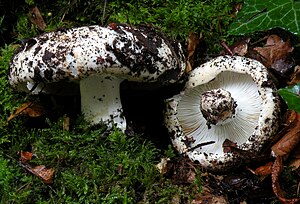Russula sect. Plorantes
| Russula sect. Plorantes | ||||||||||||
|---|---|---|---|---|---|---|---|---|---|---|---|---|

The common white-deaf ( Russula delica ) is the type species of the Plorantes section |
||||||||||||
| Systematics | ||||||||||||
|
||||||||||||
| Scientific name | ||||||||||||
| Russula sect. Plorantes | ||||||||||||
| ( Bataille ) Singer |
Russula sect. Plorantes or Lactarioides (after Sarnari) is a section from the genus Russula , which is within the subgenus Compactae . In terms of their appearance, they resemble the large, white dairy dogs of the Albati section, to which they are actually closely related. Therefore the name Lactarioides is favored for this sectiontoday.
features
Section Plorantes (Lactarioides)
The representatives of this section are mostly large pigeons, which have roughly the same habitus as the large milklings from the section Albati , because the hat is almost always funnel-shaped. It is compact, fleshy and smooth and whitish, beige to pale brown in color. The edge is often wavy. The lamellas are mixed with many, uneven intermediate lamellas, but never forked. In young fruit bodies, the lamellae can also tear, which means that they secrete water-clear drops. The meat is firm, but mostly fragile and more or less whitish. It does not blacken or redden when injured. With age, the flesh and the whole fruiting body can turn a little darker.
The hat skin is devoid of characteristic hyphae cells. Pileocystidia are usually present, but are rarely absent. The cystidia and basidia in the lamellae are more or less large. The spore ornament is more developed and the hillock is clearly amyloid . Pigments are rare and mostly limited to a blue zone at the base of the lamella at the tip of the stem. The lamellas can also have a bluish tinge.
- The type species is Russula delica , the common white-blubber .
Systematics
The Plorantes or Lactarioides , as they are called in Sarnari , are in Sarnari, Romagnesi and Bon within the subgenus Compacta (e) , and are thus a sister taxon to the Nigricantinae (or Compactae). More recent molecular biological work shows, however, that the two sister taxa are less closely related to each other and at least as strongly related to other groups from the Russula strain. Bon divides his section Plorantes into the subsections Delicinae and Pallidosporinae . Here, too, sequence analyzes of the R-DNA show that although both taxa originate at the base of the family tree, they are otherwise not closely related.
Pallidosporinae subsection
The subsection contains medium-sized to large species that look quite similar to the white-blubber, but have yellow (and not greenish) lamellae. The spore powder is also ocher-cream-colored to yellow. The spores measure 9 × 7 µm and the hillock is quite amyloid. The Pileocystidia stain weakly in sulfobenzaldehyde. The epicuticular hyphae cells are 2–4 (5) µm wide.
- The type species is Russula pallidospora , the yellow-leaved blubber .
| German species name | Scientific species name | author |
|---|---|---|
| Yellow-pored blubber | Russula flavispora | Romagn. (1967) |
| Russula littoralis | Russula littoralis | Romagn. (1972) |
| Yellow-leaved blubber | Russula pallidospora | J. Blum ex Romagn. (1967) |
| Russula pseudodelica * | Russula pseudodelica * | JE Lange (1926) |
Delicinae subsection
- The type species is Russula delica , the common white-blubber.
| German species name | Scientific species name | author |
|---|---|---|
| Narrow-leaved white blubber | Russula chloroides | (Krombh.) Bres. (1838) |
| Broad-leaved white blubber | Russula delica | Russula (1838) |
Individual evidence
- ↑ Marcel Bon (ed.): Parey's book of mushrooms . Franckh-Kosmos Verlag, Stuttgart 2005, ISBN 3-440-09970-9 , p. 72 .
- ↑ Monographic key of the russules of Europe ( Memento of July 28, 2010 in the Internet Archive ) under The Russulales Website ( Memento of the original of May 11, 2005 in the Internet Archive ) Info: The archive link was inserted automatically and has not yet been checked. Please check the original and archive link according to the instructions and then remove this notice.